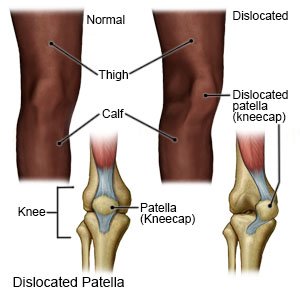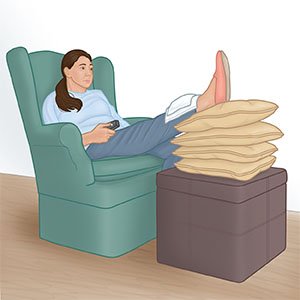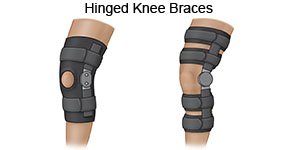Patellar Dislocation
Medically reviewed by Drugs.com. Last updated on May 6, 2024.
What is a patellar dislocation?
A patellar dislocation occurs when your patella (kneecap) is forced out of place.
 |
What increases my risk for a patellar dislocation?
- Being tall or overweight
- A kneecap that sits high or is not lined up straight in your knee joint
- Weak or imbalanced leg muscles
- A past knee injury, or a family history of knee problems
What are the signs and symptoms of a patellar dislocation?
- Pain and swelling in your knee
- Not being able to bend your knee or put weight on your leg
- A kneecap that feels out of place or a knee that gives out
How is a patellar dislocation diagnosed?
Your healthcare provider will feel your kneecap and bend your knee, moving it in different positions. Tell the provider if you had a kneecap dislocation or a knee injury in the past. Tell him or her if you have a family history of knee problems. Tell him or her if you have other health conditions.
- X-ray pictures are used to see if your patella is dislocated and if you have other injuries.
- MRI or CT pictures may be taken. You may be given contrast liquid to help your knee show up better in the pictures. Tell the healthcare provider if you have ever had an allergic reaction to contrast liquid. Do not enter the MRI room with anything metal. Metal can cause serious injury. Tell the healthcare provider if you have any metal in or on your body.
How is a patellar dislocation treated?
Your kneecap may move back into place on its own. You may need any of the following if it does not move back by itself:
- Prescription pain medicine may be given. Ask your healthcare provider how to take this medicine safely. Some prescription pain medicines contain acetaminophen. Do not take other medicines that contain acetaminophen without talking to your healthcare provider. Too much acetaminophen may cause liver damage. Prescription pain medicine may cause constipation. Ask your healthcare provider how to prevent or treat constipation.
- Acetaminophen decreases pain and fever. It is available without a doctor's order. Ask how much to take and how often to take it. Follow directions. Read the labels of all other medicines you are using to see if they also contain acetaminophen, or ask your doctor or pharmacist. Acetaminophen can cause liver damage if not taken correctly.
- NSAIDs , such as ibuprofen, help decrease swelling, pain, and fever. This medicine is available with or without a doctor's order. NSAIDs can cause stomach bleeding or kidney problems in certain people. If you take blood thinner medicine, always ask if NSAIDs are safe for you. Always read the medicine label and follow directions. Do not give these medicines to children younger than 6 months without direction from a healthcare provider.
- A procedure may be used to move your kneecap back into place. Healthcare providers will move your knee and leg in different positions until your kneecap is where it belongs.
- Aspiration is a procedure to remove blood and fluid from your knee through a needle. This reduces swelling and pain.
- Surgery may be needed if healthcare providers cannot move your kneecap back into place. Surgery may also be done if your kneecap dislocates more than 1 time.
What can I do to manage a patellar dislocation?
- Apply ice. Ice helps decrease swelling and pain, and may help prevent tissue damage. Use an ice pack, or put crushed ice in a plastic bag. Cover it with a towel and place it on your knee for 15 to 20 minutes every hour or as directed.
- Elevate your knee above the level of your heart as often as you can. This will help decrease swelling and pain. Prop your leg on pillows or blankets to keep your knee elevated comfortably.

- Prevent your knee from moving for up to 6 weeks or as directed. Your healthcare provider may put on a cast or splint. You may need to wear a leg brace to stabilize your knee. A leg brace can be adjusted to increase your range of motion as your knee heals.

- Use crutches if directed. Your healthcare provider may tell you not to put weight on your injured knee. Your provider will show you how to use crutches. You may need them for 4 to 6 weeks.
- Go to physical therapy if directed. A physical therapist can teach you exercises to increase the range of motion in your knee. Exercises make your knee stronger, increase balance, and decrease pain. You may also need to strengthen your stomach, back, hip, and leg muscles. You may be told to continue these exercises after physical therapy ends to help prevent another dislocation.
When should I seek immediate care?
- Your kneecap dislocates again.
- You have severe pain and swelling in your knee.
When should I call my doctor?
- You have more knee pain.
- Your knee feels like it is going to give out.
- You have questions or concerns about your condition or care.
Care Agreement
You have the right to help plan your care. Learn about your health condition and how it may be treated. Discuss treatment options with your healthcare providers to decide what care you want to receive. You always have the right to refuse treatment. The above information is an educational aid only. It is not intended as medical advice for individual conditions or treatments. Talk to your doctor, nurse or pharmacist before following any medical regimen to see if it is safe and effective for you.© Copyright Merative 2024 Information is for End User's use only and may not be sold, redistributed or otherwise used for commercial purposes.
Further information
Always consult your healthcare provider to ensure the information displayed on this page applies to your personal circumstances.
